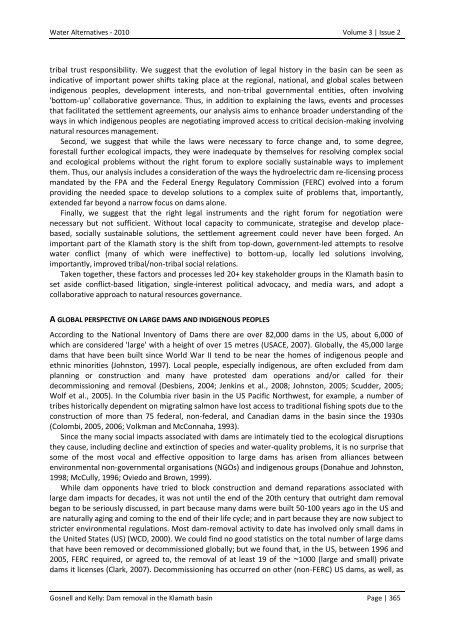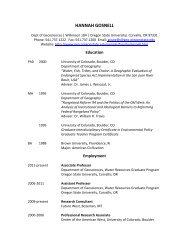Peace on the River? Social-Ecological ... - Water Alternatives
Peace on the River? Social-Ecological ... - Water Alternatives
Peace on the River? Social-Ecological ... - Water Alternatives
You also want an ePaper? Increase the reach of your titles
YUMPU automatically turns print PDFs into web optimized ePapers that Google loves.
<strong>Water</strong> <strong>Alternatives</strong> - 2010 Volume 3 | Issue 2<br />
tribal trust resp<strong>on</strong>sibility. We suggest that <strong>the</strong> evoluti<strong>on</strong> of legal history in <strong>the</strong> basin can be seen as<br />
indicative of important power shifts taking place at <strong>the</strong> regi<strong>on</strong>al, nati<strong>on</strong>al, and global scales between<br />
indigenous peoples, development interests, and n<strong>on</strong>-tribal governmental entities, often involving<br />
'bottom-up' collaborative governance. Thus, in additi<strong>on</strong> to explaining <strong>the</strong> laws, events and processes<br />
that facilitated <strong>the</strong> settlement agreements, our analysis aims to enhance broader understanding of <strong>the</strong><br />
ways in which indigenous peoples are negotiating improved access to critical decisi<strong>on</strong>-making involving<br />
natural resources management.<br />
Sec<strong>on</strong>d, we suggest that while <strong>the</strong> laws were necessary to force change and, to some degree,<br />
forestall fur<strong>the</strong>r ecological impacts, <strong>the</strong>y were inadequate by <strong>the</strong>mselves for resolving complex social<br />
and ecological problems without <strong>the</strong> right forum to explore socially sustainable ways to implement<br />
<strong>the</strong>m. Thus, our analysis includes a c<strong>on</strong>siderati<strong>on</strong> of <strong>the</strong> ways <strong>the</strong> hydroelectric dam re-licensing process<br />
mandated by <strong>the</strong> FPA and <strong>the</strong> Federal Energy Regulatory Commissi<strong>on</strong> (FERC) evolved into a forum<br />
providing <strong>the</strong> needed space to develop soluti<strong>on</strong>s to a complex suite of problems that, importantly,<br />
extended far bey<strong>on</strong>d a narrow focus <strong>on</strong> dams al<strong>on</strong>e.<br />
Finally, we suggest that <strong>the</strong> right legal instruments and <strong>the</strong> right forum for negotiati<strong>on</strong> were<br />
necessary but not sufficient. Without local capacity to communicate, strategise and develop placebased,<br />
socially sustainable soluti<strong>on</strong>s, <strong>the</strong> settlement agreement could never have been forged. An<br />
important part of <strong>the</strong> Klamath story is <strong>the</strong> shift from top-down, government-led attempts to resolve<br />
water c<strong>on</strong>flict (many of which were ineffective) to bottom-up, locally led soluti<strong>on</strong>s involving,<br />
importantly, improved tribal/n<strong>on</strong>-tribal social relati<strong>on</strong>s.<br />
Taken toge<strong>the</strong>r, <strong>the</strong>se factors and processes led 20+ key stakeholder groups in <strong>the</strong> Klamath basin to<br />
set aside c<strong>on</strong>flict-based litigati<strong>on</strong>, single-interest political advocacy, and media wars, and adopt a<br />
collaborative approach to natural resources governance.<br />
A GLOBAL PERSPECTIVE ON LARGE DAMS AND INDIGENOUS PEOPLES<br />
According to <strong>the</strong> Nati<strong>on</strong>al Inventory of Dams <strong>the</strong>re are over 82,000 dams in <strong>the</strong> US, about 6,000 of<br />
which are c<strong>on</strong>sidered 'large' with a height of over 15 metres (USACE, 2007). Globally, <strong>the</strong> 45,000 large<br />
dams that have been built since World War II tend to be near <strong>the</strong> homes of indigenous people and<br />
ethnic minorities (Johnst<strong>on</strong>, 1997). Local people, especially indigenous, are often excluded from dam<br />
planning or c<strong>on</strong>structi<strong>on</strong> and many have protested dam operati<strong>on</strong>s and/or called for <strong>the</strong>ir<br />
decommissi<strong>on</strong>ing and removal (Desbiens, 2004; Jenkins et al., 2008; Johnst<strong>on</strong>, 2005; Scudder, 2005;<br />
Wolf et al., 2005). In <strong>the</strong> Columbia river basin in <strong>the</strong> US Pacific Northwest, for example, a number of<br />
tribes historically dependent <strong>on</strong> migrating salm<strong>on</strong> have lost access to traditi<strong>on</strong>al fishing spots due to <strong>the</strong><br />
c<strong>on</strong>structi<strong>on</strong> of more than 75 federal, n<strong>on</strong>-federal, and Canadian dams in <strong>the</strong> basin since <strong>the</strong> 1930s<br />
(Colombi, 2005, 2006; Volkman and McC<strong>on</strong>naha, 1993).<br />
Since <strong>the</strong> many social impacts associated with dams are intimately tied to <strong>the</strong> ecological disrupti<strong>on</strong>s<br />
<strong>the</strong>y cause, including decline and extincti<strong>on</strong> of species and water-quality problems, it is no surprise that<br />
some of <strong>the</strong> most vocal and effective oppositi<strong>on</strong> to large dams has arisen from alliances between<br />
envir<strong>on</strong>mental n<strong>on</strong>-governmental organisati<strong>on</strong>s (NGOs) and indigenous groups (D<strong>on</strong>ahue and Johnst<strong>on</strong>,<br />
1998; McCully, 1996; Oviedo and Brown, 1999).<br />
While dam opp<strong>on</strong>ents have tried to block c<strong>on</strong>structi<strong>on</strong> and demand reparati<strong>on</strong>s associated with<br />
large dam impacts for decades, it was not until <strong>the</strong> end of <strong>the</strong> 20th century that outright dam removal<br />
began to be seriously discussed, in part because many dams were built 50-100 years ago in <strong>the</strong> US and<br />
are naturally aging and coming to <strong>the</strong> end of <strong>the</strong>ir life cycle; and in part because <strong>the</strong>y are now subject to<br />
stricter envir<strong>on</strong>mental regulati<strong>on</strong>s. Most dam-removal activity to date has involved <strong>on</strong>ly small dams in<br />
<strong>the</strong> United States (US) (WCD, 2000). We could find no good statistics <strong>on</strong> <strong>the</strong> total number of large dams<br />
that have been removed or decommissi<strong>on</strong>ed globally; but we found that, in <strong>the</strong> US, between 1996 and<br />
2005, FERC required, or agreed to, <strong>the</strong> removal of at least 19 of <strong>the</strong> ~1000 (large and small) private<br />
dams it licenses (Clark, 2007). Decommissi<strong>on</strong>ing has occurred <strong>on</strong> o<strong>the</strong>r (n<strong>on</strong>-FERC) US dams, as well, as<br />
Gosnell and Kelly: Dam removal in <strong>the</strong> Klamath basin Page | 365






